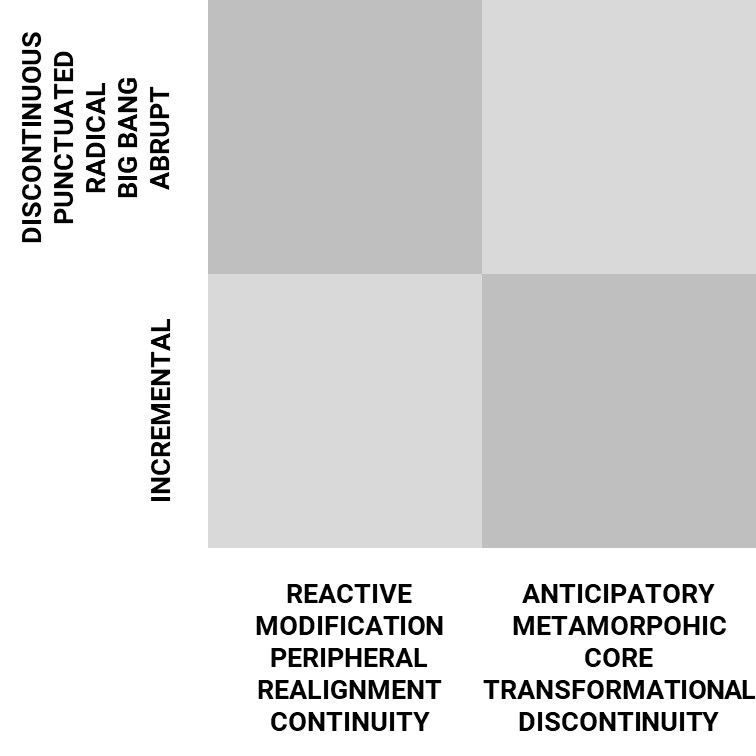Degrees of Change
My recent post on our Sales tips from conditions for the arrival of political change got me thinking.
Most buyers can think in terms of 'change' when they want it. But they tend to focus on the one-size-fits-all impacts of it. Rather than considering the nuances from implications of the scale of it.
I'm full of models framing change as a process. How the march or stall of change works, flows or cycles. I cite them regularly.
Yet lesser used, are interesting frameworks you can talk a friendly prospect through to gauge what you (we) are potentially up against in setting said change in train.
Less about the reactions to change - whilst massively important - but more about the reasoning, forces, imperative behind the mooted, required, demanded change.
2x2 junkie as I am, here's a quintet of boxes for starters. In turn, from 1995, 1998, 2003, 2004 & 2005. They each use a similar nature of change scale.
Nadler & Tushman produced their mid-90s version looking at the level of it from incremental to discontinuous (which I've also seen labelled transformational and strategic). Then seeks to assess how in control of it we may be in terms of time pressure, with driving force scale from reactive to anticipatory.
The model of Piet Human came from looking at S Africa's late-90s public sector embrace of democracy. (I'll come back to this later). His matrix looks at approach of incremental to punctuated (his term for 'rapid'). With type ranging from modification to metamorphic, suggesting slight to most significant.
Gus Pennington's assessment built for Higher Education administrators judging disturbance and risk levels, comes from axes related to the change going from incremental to radical, and core to peripheral.
Balogun & Hope Hailey introduce big bang as the other end of their nature of change spectrum to incremental. Pitted against a result continuum from realignment to transformational.
Streeck & Thelen's incremental reading moves on to swapping in abrupt at the far end. Then looks instead of where the change hits, to rather think on the intended result for the other axis. Namely continuity or discontinuity.
Shared is the need to pick a place from incremental to its opposite. Whether you call it punctuated, discontinuous, radical, big bang or abrupt, this level of intensity can produce something delicious to talk over with a prospect.
Then we've a choice for our other reading.
There's a fair amount of crossover among these five matrices.
I'm tempted to present a shortcut. Not normally in my nature. Yet as a hack, my leaning is that it almost doesn't matter which second axis you use.
Forearmed with these, you likely have a feel for which might best apply anyway.
The output though, is to ensure that once a plot is placed on your matrix, it must help you together shape how to go about making said change happen. Smoother over rougher.
The aim is to get the prospect cognisant of journey ahead and help provide a map to navigate through to destination of reaping the fruits of taking on your Proposal.
These are not only audit tools to determine where they sit right now, but crucially enable you to make the most apt joint plan together to ensure we both prevail.
Wherever you plot your bid/their procurement, there's a name or label for that quadrant in which they sit. Along with accompanying advice on how to best deal with such a spot.
As for taking ideas farther, there are other concepts you can introduce.
Another matrix could mark the change as short- or long-term. Against whether they address a threat or opportunity.
Away from 2x2, you could also plot on a standard x-y line graph for zones of Agreement and Certainty (Stacey, 1999).
And a final useful point to use I think also comes from Piet Human's offering from above. (His book is entitled Yenza, one local word for 'do it'). He coined the term 'revocrats' to brand the bureaucrats with the power of change. As an aside, this is interesting to us as a way of finding our buyerside 'revocracy'. If we need revolutionaries, they may well respond positively to such a tag. Maybe even as a banner to rally behind.

